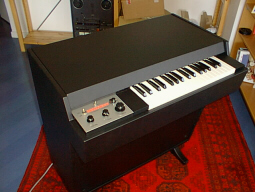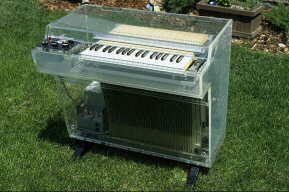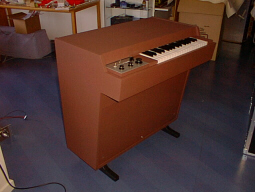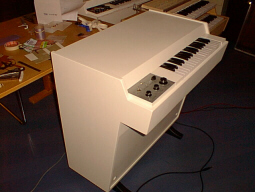

RHYME OF THE ANCIENT KEYBOARDS
Mellotron




The first analogic
sampler, invented around 1960, it can provide the sounds of a
string ensemble, cellos, flutes, brass and choir. The pressure of
the keys causes the playback of strips of magnetic tape on which
those sound were previously recorded. Due to the limited length
of the tape, only 8 seconds of continuous sound could be produced,
before the mechanism rewinded it! Its strange, unearthy sound has
marked the composition of nearly all prog-rock masters (Genesis,
Yes, King Crimson, Strawbs, Moody
Blues) and many others (The Beatles, Bee Gees, etc).
For 20 years considered obsolete, now it
enjoys a second youth: an improved Mk.VI version is now built
and besides the new generation prog bands, also many "trendy" rock
artists use it now (Red Hot Chili Peppers, Smashing Pumpkins, even Oasis!);
visit Mellotron Archives to know more: ![]()
Moog Synthesizer




One of the first analogic monophonic synthesizers. For the first time the sound could be manipulated to emulate other instruments or just to create an original timbre. The core of the instrument was an electronic oscillator producing various waveforms, the timbre was varied by a phylter and modified by the envelope selector. Keith Emerson, following the advices from inventor Dr.Robert Moog, was the first musician to use it for a rock composition (Lucky Man). It used to go out of tune easily, and in EL&P's film "Pictures At An Exhibition" you can see Keith turn quickly the knobs during the performance, in order to tune it again
Hammond Organ


The rock organ since the 60's, the original instrument was electromechanical in nature, based on the principle of cog-wheels rotating before magnets to produce layered soundwaves. It was complemented by Leslie amplifier-speakers. To modify the timbre, nine drawbars were avalaible, the combination of which produced the personal sound of all players (they often kept it secret). Although Rick Wakeman, Keith Emerson and Jon Lord (Deep Purple) were the most awarded Hammond players of the 70's, this instrument is also present in The Beatles' "Let It Be", played by Billy Preston, and in uncountable R'n'B bands. The modern Hammond Organ works in a totally electronic way, but some say the sound is nothing like the original one (but neither the weight!)